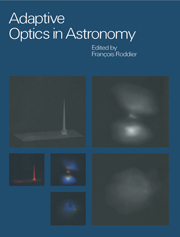Book contents
- Frontmatter
- Contents
- List of contributors
- Part one Introductory background
- Part two The design of an adaptive optics system
- Part three Adaptive optics with natural guide stars
- Part four Adaptive optics with laser beacons
- 11 Overview of adaptive optics with laser beacons
- 12 The design of laser beacon AO systems
- 13 Laser beacon adaptive optics systems
- Part five The impact of adaptive optics in astronomy
- Glossary of acronyms
- Index
12 - The design of laser beacon AO systems
from Part four - Adaptive optics with laser beacons
Published online by Cambridge University Press: 23 November 2009
- Frontmatter
- Contents
- List of contributors
- Part one Introductory background
- Part two The design of an adaptive optics system
- Part three Adaptive optics with natural guide stars
- Part four Adaptive optics with laser beacons
- 11 Overview of adaptive optics with laser beacons
- 12 The design of laser beacon AO systems
- 13 Laser beacon adaptive optics systems
- Part five The impact of adaptive optics in astronomy
- Glossary of acronyms
- Index
Summary
Introduction: outline of the chapter
In this chapter, the design of LGS AO is treated, with special emphasis on analysis tools required for predicting the expected performance of laser beacon adaptive optics on astronomical telescopes. Analytical expressions are given for estimating the most important error sources encountered in LGS AO operation. Numerical examples are given to illustrate the relative importance of various errors, and to aid in the choice of design parameters.
There have been several treatments of LGS error budget analyses (for example: Gardner et al. 1990; Kibblewhite 1992; Gavel et al. 1994; Parenti and Sasiela 1994; Olivier and Gavel 1994) each emphasizing different aspects of LGS AO, and using a wide assortment of approximations. While the tools discussed in this chapter have general applicability to LGS AO, the treatment (which parallels and extends that of Sandler et al. 1994a) is aimed at diffraction-limited imaging on astronomical telescopes, with the goal of optimizing performance for near-infrared imaging and spectroscopy for the new large telescopes, as discussed in Chapter 11. Examples are often chosen which are relevant to this problem.
We begin in Section 12.2 by decomposing the AO system error into image motion, or tilt errors and higher order wave-front errors. In the regime of diffraction-limited correction, the tilt and high order wave front errors can be treated independently, with corresponding Strehl ratios Sθ and Sφ, respectively.
- Type
- Chapter
- Information
- Adaptive Optics in Astronomy , pp. 271 - 330Publisher: Cambridge University PressPrint publication year: 1999



